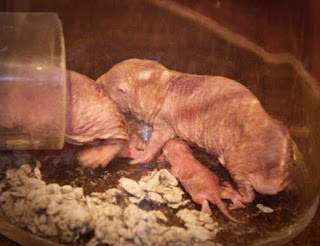
What is that naked mole rat doing? Pacific Science Center's mole rat colony provokes this question frequently, but never more so than when animals solicit cecotropes.

The cecum (pronounced see-kum) is a portion of the digestive system in some species of animals, located between the small and large intestine. When food passes into the large intestine, the indigestible fiber is passed through as normal feces. However, portions that still contain nutrients are pushed back into the cecum where they are broken down into starches, sugars and vitamins. This material is then passed as cecal pellets or cecotropes, which the animal reingests.

Yes, the animal eats them. To a human, this is a strange concept. But to a naked mole rat with a diet high in fiber and low in calories, every bit of nutrition must be captured. By recycling nutrients that cannot be absorbed the first time, the animal is able to survive on a diet that would not support many other species. You can often watch a mole-rat assume a curled up sitting position allowing their head to reach far enough to ingest their own pellets.
Cecotropes are more than just nutrient-rich pellets. They also contain beneficial live cultures which the mole-rats need to properly digest their food. Baby naked mole-rats do not yet have these microbes and need to get them in order to survive. So as they begin to eat solid food, they will solicit older animals and beg for cecotropes. Late in her pregnancy, when her mobility is limited, the queen will also demand pellets.

Mole-rats do not normally produce these pellets on demand, and donor animals may be seen jumping or shaking violently in the process of producing them. Often when pups are involved, it looks as though an older animal may harm a pup, when in fact it is helping.

The ability and need to produce cecotropes may be part of the reason naked mole-rats are eusocial. All mammals need nutrition from their mother in the form of milk. For mole-rat pups, cecal pellets are a second form of necessary nutritive care, and one that can be provided by any member of the colony. This ability gives the queen a shorter turn-around time to focus her nutrient store on producing the next litter, while workers continue to provide for the existing pups.

Nice informative blog update. :D
ReplyDelete" and donor animals may be seen jumping or shaking violently in the process of producing them"... That happened to me once too in the bathroom. :D
Yours sincerely
Jesper K. Boesen